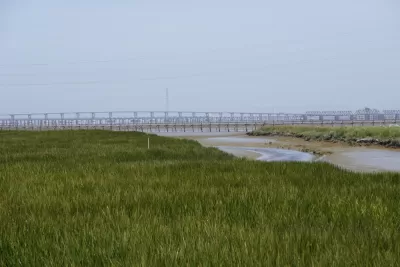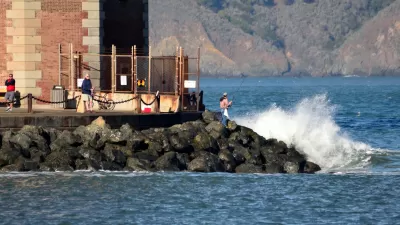For the next several months, nine sites will be the focus of efforts to design for resilience as sea levels rise. Proposals involve "threading nature back into an urbanized terrain."

Resilient by Design's Bay Area Challenge has put ten multidisciplinary teams to work conceptualizing "a region where cities and nature are entwined more closely than ever before." Their impetus: the need to design places that can handle rising seas.
As John King writes, "The challenge, which is being funded by local governments and the Rockefeller Foundation, is modeled on New York and New Jersey’s rebuilding effort after Hurricane Sandy in 2012."
The Bay Area effort, by contrast, isn't a response to "calamitous damage." It's a bid to prepare for a gradual threat, and invites participants to reimagine how cities interact with nature. Many of the designs, King says, involve "threading nature back into an urbanized terrain, so to speak."
The challenge began with a competition last year, with the ten winning teams each receiving $250,000 for their projects. The final proposals are expected in May. "The months ahead will be spent burrowing into the specific locations, and reaching out to the surrounding communities to make sure there's widespread participation in the final proposals."
FULL STORY: Design competition tackles sites around Bay Area to address rising waters

Trump Administration Could Effectively End Housing Voucher Program
Federal officials are eyeing major cuts to the Section 8 program that helps millions of low-income households pay rent.

Planetizen Federal Action Tracker
A weekly monitor of how Trump’s orders and actions are impacting planners and planning in America.

Ken Jennings Launches Transit Web Series
The Jeopardy champ wants you to ride public transit.

Crime Continues to Drop on Philly, San Francisco Transit Systems
SEPTA and BART both saw significant declines in violent crime in the first quarter of 2025.

How South LA Green Spaces Power Community Health and Hope
Green spaces like South L.A. Wetlands Park are helping South Los Angeles residents promote healthy lifestyles, build community, and advocate for improvements that reflect local needs in historically underserved neighborhoods.

Sacramento Plans ‘Quick-Build’ Road Safety Projects
The city wants to accelerate small-scale safety improvements that use low-cost equipment to make an impact at dangerous intersections.
Urban Design for Planners 1: Software Tools
This six-course series explores essential urban design concepts using open source software and equips planners with the tools they need to participate fully in the urban design process.
Planning for Universal Design
Learn the tools for implementing Universal Design in planning regulations.
Heyer Gruel & Associates PA
Ada County Highway District
Institute for Housing and Urban Development Studies (IHS)
City of Grandview
Harvard GSD Executive Education
Toledo-Lucas County Plan Commissions
Salt Lake City
NYU Wagner Graduate School of Public Service




























